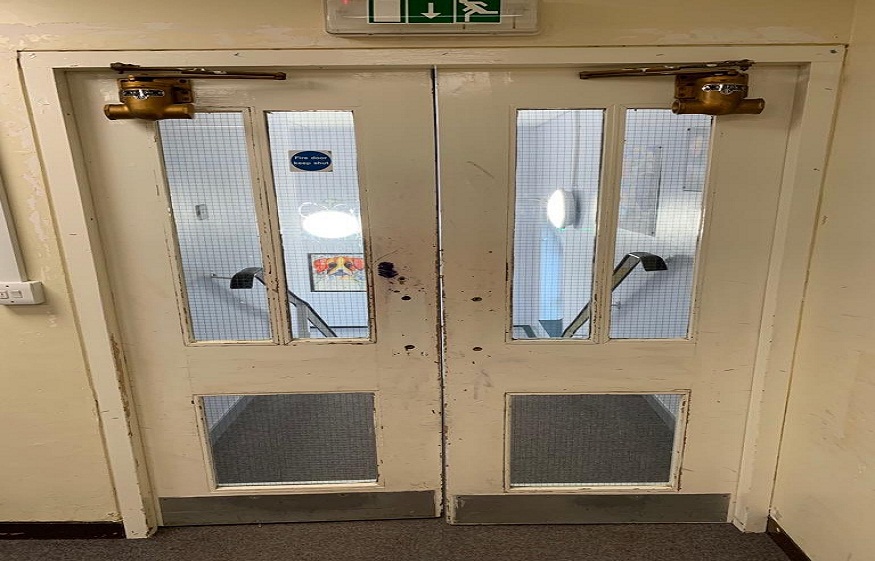Fire doors are a vital component of a building’s fire protection strategy. They are designed to delay the spread of fire and smoke, protect escape routes, and save lives. In multi-occupancy buildings, commercial premises, and public facilities, these doors serve as crucial barriers that allow occupants to evacuate safely during a fire.
While fire doors must be professionally inspected and maintained by qualified experts regularly, property and facilities managers must also carry out more frequent checks as part of their day-to-day responsibilities. These routine visual inspections can help catch issues early, ensuring fire doors remain compliant and functional between scheduled professional inspections.
This article offers a step-by-step guide on performing a basic fire door check, helping property managers uphold fire safety standards and avoid potentially costly or dangerous oversights. Capital Fire Doors’ inspection services are available for more in-depth evaluations, providing expert advice and ensuring full compliance with current legislation.
Why Fire Door Checks Matter
Under the Regulatory Reform (Fire Safety) Order 2005, the responsible person—typically the building owner, facilities manager, or managing agent—is legally required to ensure that all fire safety equipment, including fire doors, is maintained in good working condition.
In addition, the Fire Safety (England) Regulations 2022 now require regular checks on fire doors in multi-occupancy residential buildings. For example, flat entrance doors must be checked at least once a year, while communal doors must be checked every three months.
Neglecting this responsibility can result in non-compliance, invalidated insurance, fines, and, most critically, increased risk to building occupants.
When Should a Fire Door Be Checked?
While a professional inspection should be carried out annually (or more frequently for high-traffic areas), routine in-house checks should be conducted more often—ideally monthly or quarterly, depending on the building type and usage.
If you’re unsure whether your current maintenance plan meets requirements, Capital Fire Doors offers expert maintenance packages tailored to your building’s needs
Tools You May Need
Before beginning, you may find the following helpful:
- A torch (for checking seals and labels in dim areas)
- A clipboard or checklist
- A tape measure
- A notepad or mobile device to record findings
- Access to your building’s fire door inventory (if available)
Step-by-Step Guide: How to Check a Fire Door
1. Confirm the Door Is a Fire Door
Not all doors are fire doors. To confirm, check for certification labels or plugs on the top edge or side of the door. This should include details like the manufacturer, fire rating (e.g. FD30 or FD60), and compliance certification.
If the label is missing or illegible, it’s best to consult with a fire door professional. Capital Fire Doors can help verify the door’s certification and replace any non-compliant.
2. Inspect the Door Leaf
The door leaf (the central moving part of the door) should be in good condition with no significant damage. Look for:
- Cracks splits, or holes in the door
- Signs of warping
- Damage at the top or bottom edge
- Impact marks from trolleys or equipment (standard in commercial settings)
Surface damage can reduce the door’s fire resistance. If in doubt, seek a professional assessment.
3. Check the Frame
The frame should be securely fixed and free from warping or deterioration. Look for:
- Gaps between the door and the frame—these should be 3-4mm along the sides and top
- Gaps at the bottom—no more than 8mm (or 3mm if smoke seals are fitted)
- Signs of wear or cracking at fixings
Excessive gaps allow smoke and fire to pass through and can prevent the door from operating correctly.
4. Inspect the Seals
Intumescent and smoke seals are vital for containing fire and smoke. These are usually fitted in the frame or along the edge of the door and should be:
- Continuous and unbroken
- Firmly attached
- Free from damage, paint, or obstruction
If the seals are missing or damaged, they must be replaced immediately. This is a common failure point identified in professional fire door inspections.
5. Test the Hinges
Most fire doors are fitted with three or more hinges. Check that:
- All hinges are firmly fixed with no missing screws
- There is no sign of rust, oil leakage, or damage
- Hinges are CE-marked and suitable for fire doors
Loose or broken hinges may cause the door to hang incorrectly or fail to close fully.
6. Test the Self-Closing Mechanism
Fire doors must be fitted with a self-closing device unless exempted. To test:
- Open the door halfway and release it
- It should close fully and latch without sticking or slamming
The self-closer may need adjustment or replacement if the door doesn’t close fully or needs to be pulled shut.
7. Check the Latch and Lock
Ensure that the latch engages correctly with the strike plate. You should:
- Listen for any scraping or grinding noises
- Ensure the lock is fire-rated if fitted (non-fire-rated locks can compromise performance)
What to Do If You Identify a Problem
If the above checks fail, the fire door may not be compliant. Minor issues, such as loose hinges or dirty seals, can often be addressed in-house. However, more serious problems—such as warped doors, non-compliant gaps, or faulty closers—require professional intervention.
Engaging a qualified provider like Capital Fire Doors ensures that any repairs or replacements fully comply with current legislation and best practices.
For regular servicing and long-term care, Capital Fire Doors’ maintenance packages provide peace of mind and keep your building safe year-round.
Record-Keeping and Documentation
As part of your fire safety strategy, you should document all fire door checks, including:
- Date of inspection
- Location and ID of the door
- Any issues found
- Action taken or recommended
- Inspector’s name and signature
Fire safety authorities or insurers may request this record in the event of an incident.
Educating Occupants
In multi-occupancy and commercial buildings, users may unknowingly compromise fire safety by:
- Propping open fire doors
- Blocking them with furniture
- Removing or damaging seals or closers
Ensure all occupants understand the importance of fire doors and their role in keeping the building safe. Displaying fire safety signage near fire doors and including reminders in tenant or staff communications can be helpful.
Conclusion
Regular fire door checks are crucial to any building’s fire safety routine. Property managers can identify potential issues early by following this simple step-by-step guide, ensuring legal compliance and creating a safer environment for all occupants. However, it’s important to remember that visual checks are not a substitute for professional inspections.
For expert support, certified maintenance, or urgent repairs, Capital Fire Doors offers reliable, nationwide services tailored to the needs of commercial, residential, and public buildings. Their inspection and maintenance teams help keep your fire doors compliant, functional, and ready to perform when it matters most.

